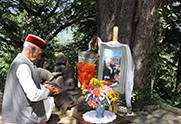|
On August 26 in honour of Mrs. Lyudmila V. Shaposhnikova a special puja was conducted in the Roerich Estate. It was Gita-path, a holy rite accompanied by the chanting of Bhagavad Gita, one of the most venerated spiritual and philosophical texts of the world.
It is with profound sorrow that the Russian and Indian employees of the International Roerich Memorial Trust learnt the tragic news of the demise of Lyudmila V. Shaposhnikova – the founder and Director General of the Non-governmental Centre-Museum named after Nicholas Roerich, Moscow, the extraordinary Indologist, writer and the eminent scholar of the life and creative work of the Roerich family.
Mrs. Lyudmila V. Shaposhnikova is well-remembered in Naggar. Many a time along with Svetoslav Roerich she visited the Himalayan estate of the Russian family of the Roerichs and worked heart and soul for its preservation and development. When Svetoslav Roerich was setting up the International Roerich Memorial Trust in 1992-1993 he appointed Mr. Alexander M. Kadakin, Ambassador of the Russian Federation in the Republic of India, and his own close associate Mrs. Lyudmila V. Shaposhnikova, Director General, Museum Named after Nicholas Roerich, Moscow life-trustees from the Russian side. The Agreement of Cooperation between the International Roerich Memorial Trust, Naggar and the International Centre of the Roerichs, Moscow signed on Mrs. Shaposhnikova’s initiative became an important stage in the realization of the joint Russian and Indian plans regarding the creation of an international cultural center in Naggar.
It was in 2004 that Mrs. Shaposhnikova visited Naggar for the last time attending the celebrations of the 100th anniversary of Svetoslav Roerich. But in her heart of hearts she never parted either with the Kullu valley, which was so dear to her or with the Roerich Estate suffused with the spiritual energies of the heroic labour of that family.
On August 26 in honour of Mrs. Lyudmila V. Shaposhnikova a special puja was conducted in the Roerich Estate. It was Gita-path, a holy rite accompanied by the chanting of Bhagavad Gita, one of the most venerated spiritual and philosophical texts of the world. In this long poem, which Helena Roerich called the pearl of oriental scriptures Krishna and his disciple Arjuna discuss the immortality and eternity of soul, establish the necessity of following one’s duty and accepting one’s responsibility and stress the importance of selfless service. In India they believe that chanting of Bhagavad Gita helps one’s soul to free itself from the shackles of the matter and have a safe journey to the afterlife.
The puja was held under the memorable Himalayan pine near the Roerich House where the images of the deities and protectors of the Kullu valley have formed a sort of an open temple. For six hours the venerable pujari from the ancient Krishna temple in Naggar had been reciting Bhagavad Gita or the Divine Song asking the Higher Powers to have mercy on the soul of the departed and accept her in their heavenly abode... The easy wind was spreading the smoke of the incense sticks and shrouding in it the picture of Mrs. Shaposhnikova and then carrying it up towards the tops of green deodars. A beautiful butterfly circled over the participants of the ceremony and then gently landed on the flower in the bouquet placed before the picture of the demised. There it remained for not less than an hour. The stone faces of gods and goddesses observed the ceremony steeped in the silence of their wisdom. And far away glittered the snowy twin peaks of Gepang...
Mr. Rakesh Kanwar, Director IRMT – cum - DC Kullu called Mrs. Lyudmila Shaposhnikova a “great soul.” Her demise is an irreparable loss for us. Her noble image, knowledge, wisdom, perseverance and courage will forever remain with us. Our task is to preserve the Non-governmental Museum named after Nicholas Roerich, Moscow created by her, to fulfill her dream of developing the IRMT into a world-class cultural center and to carry on her work of protecting the name and legacy of the Roerichs and propagating their evolutionary ideas.
| 
